(Updated Jan. 2008)
Stories of Childhood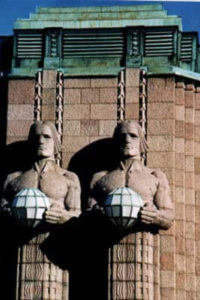
It is evening in Cafe Maki in downtown Helsinki where we sit with our lesbian friend Hilkka and her close gay comrades around a few cups of brew, coffee and cola. The music is soft, the ambiance is dim and voices from other patrons are calm.
Strangers meeting for the first time (off line), we are collected together and feel an easy immediate camaraderie among us, induced I think in part by the prosperous and unrepressed culture that inhabits this Nordic land.
I ask around the table about their first stirrings of gay feelings.
“I felt I was gay from a very young age; a friend and I used to play a game where he was a cowboy and I was an Indian princess–he kidnapped and took me to his house he would pretend to make me his wife…” So runs an early memory for Petri sitting close to his partner Tuomas as he recalls a childhood image of being gay in Finland. He is a 22 year-old university student with blond, slightly spiked hair, blue eyes and an enviably lean body.
Tuomos, 23 , with dark eyes, soft red-brown hair parted in the middle and a sweet broad-lipped smile, joins in. He and Petri have been lovers for three years. ” I recall it came as easily as it would come being straight. I had a secret feeling about toward men; I tried to pretend to like girls so I made fantasies about girls. Around the age of eleven I just started having erotic dreams and fantasies that concerned only men, and I liked that better! I didn’t have a word for it though. When I was 16, I thought I must be gay! But I didn’t tell anyone until Hilkka.
 Hilkka, with her short-cropped red hair, looks like a fashion model. She recalls, “from the time I was little I looked at all the women’s magazines and that was what I thought I should do. Later I was engaged to be married, but I didn’t want to and I was very confused. It was a time of great crisis in my life until I understood what was wrong–nothing! I liked women and wanted to marry one of them instead. But you can’t say that to your mother…”
Hilkka, with her short-cropped red hair, looks like a fashion model. She recalls, “from the time I was little I looked at all the women’s magazines and that was what I thought I should do. Later I was engaged to be married, but I didn’t want to and I was very confused. It was a time of great crisis in my life until I understood what was wrong–nothing! I liked women and wanted to marry one of them instead. But you can’t say that to your mother…”
Laughing at the past is much easier, of course, after those private discoveries led to clearer understanding of one’s own gay identity. Emerging from the crush and confusion of a semi-queer pubescence so enmeshed in a heterosexist social maze is a universal quandary–no different in Finland than anywhere else.
Privilege and Freedom
For lesbigays in Finland, after the puzzle is solved, there is a big difference from most countries of the world. “All persons shall be equal before the law. No-one shall, without acceptable grounds, be afforded a different status on account of sex, age, origin, language, religion, conviction, opinion, state of health, disability or any other reason related to the person…” Sexual orientation is specifically mentioned as an example of “other reason related to the person”. So reads the Finnish Constitution.
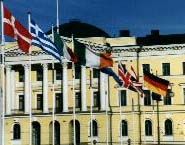 To be gay in modern Finland, in a streamline culture of efficiency and dignity, is to be privileged with access to prosperity, personal freedom and positive political attitudes toward homosexuality. In Finland and only a handful of other countries (mostly northern Europe) is sexual orientation a protected condition along with other natural human attributes such as age, gender and ethnicity.
To be gay in modern Finland, in a streamline culture of efficiency and dignity, is to be privileged with access to prosperity, personal freedom and positive political attitudes toward homosexuality. In Finland and only a handful of other countries (mostly northern Europe) is sexual orientation a protected condition along with other natural human attributes such as age, gender and ethnicity.
The consequence of such affirmation is confidence, trust, security and a willingness to contribute back to the society that acknowledges the inherent dignity for all. And so today throughout Helsinki and other urban centers gays and lesbians gather casually and freely in cafes, clubs, discos or at the university to plan their days and their lives without a shadow of apprehension. Crime in Finland is among the lowest is Europe and, expectedly, so is homophobia.
Not a Perfect Climate
This is not to suggest a pure attitude exists uniformly across the country; no culture is devoid of intolerance arising from ignorance. Petri comes from Orivesi, a small north-central rural city which he was glad to leave after high school where he had been teased regularly for his soft masculine appearance. Although he never faced any physical threats, he still felt ostracized and humiliated by some of his bullying peers.
The remedy was to go to the university in Helsinki where he now feels much more accepted by gay and straight peers–especially his partner Tuomas with whom he has lived for two of their three years together. At the university there is a large lesbigay organization called OHO with it own website (see link). Which describes itself as: ” The biggest, queerest and gayest bunch of sexually non-normative students at the University of Helsinki — that’s OHO!” This is where Petri feels very validated as he begins to construct his long future.
Friends and Lovers
No different than any other Friday night, Hilkka and her gay boy friends collect for a drink at the Lost and Found Cafe (“a hetero friendly place”) near the center of downtown among a very eclectic mix of deco and classical architecture. These are bright young people focused on boundless futures: careers as teachers, designers, lawyers, sailors or politicians (any profession is open here), romances, university appointments, places to live, trips to the continent, a new winter coat and a great new CD.
 Hilkka, a sort of young den mother to her friends, is unmistakable in her bright round face and arresting red hair. She is a full time employee in the Helsinki Stock Exchange. Having spent a year in Ireland refining her English, she speaks with a charming mixed accent as she tells of her family. “My mother still hints at becoming a grandmother; how many years of girlfriends does it take to cure her of such ideas?”
Hilkka, a sort of young den mother to her friends, is unmistakable in her bright round face and arresting red hair. She is a full time employee in the Helsinki Stock Exchange. Having spent a year in Ireland refining her English, she speaks with a charming mixed accent as she tells of her family. “My mother still hints at becoming a grandmother; how many years of girlfriends does it take to cure her of such ideas?”
Their stories are not ponderous or emotionally disturbing and their concerns are not revolutionary. But that is the point here. These young people live in a condition of societal grace that suffuses our evening meal with relaxed, humorous, and openhearted sharing together. These homosexual denizens are full status citizens here, unafraid of any force or coercion from religious or political zeal that could wish them harm.
Hilkka is fretting about the discord with her girlfriend who has become over-possessive in the past few months and cloying to the point where Hilkka is considering leaving.
A silent member of the group, Timo, has hardly spoken a word since we first sat down. At first, I can hear that his English is not as fluent as the others so I didn’t point many questions at him. Some time later, Hilkka revealed that Timo’s lover of seven years had left him only a few days before, more than sufficient reason to be sullen and silent.
Problems of the Good Life
Tuomas and Petri are the young-in-love couple, for three years now, and finally living together at the university for the past ten months. Along with their academic work–Petri in interior design and Tuomas in computer engineering–they are trying to work around the apparent inequalities of the university housing policies for couples which, at the present time, don’t allow for same-sex couples.
If it is found that Tuomas has a ‘roommate’ his government housing subsidy may be reduced–instead of increased as it is for married couples. Their friend Kevin, (“he’s not gay but we let him be our friend anyway!”) is also sitting at our table. He is an American lawyer living in Helsinki who explains this legal loophole of the otherwise liberal government. “Since the legislature has not ruled specifically on this issue yet, the University claims its policies are not discriminatory at the same time it admits the unfairness…but that will hopefully change next year”, he says, referring to the impending domestic partner legislation before the parliament.
Church and State
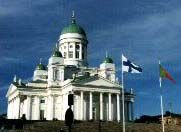 One of the most striking aspects of life in Scandinavia (to an American visitor) is the role of the church and state in each other’s affairs. Because the Lutheran church is the official state church, all citizens are born into the church and are considered members until a person resigns in writing. But most people don’t bother with church matters: 95% of the population do not go to church regularly.
One of the most striking aspects of life in Scandinavia (to an American visitor) is the role of the church and state in each other’s affairs. Because the Lutheran church is the official state church, all citizens are born into the church and are considered members until a person resigns in writing. But most people don’t bother with church matters: 95% of the population do not go to church regularly.
Finland is a mostly secular, nature-loving culture. The church is a semi-official body of the government and is bound by the laws and policies set by the democratic parliament. When the governments, first in Denmark, then Sweden, Norway and finally Finland in 1998, expanded anti-discrimination laws to include sexual orientation, the church had no choice but to follow suit, in principle, although the legislation was vocally opposed by some higher church clergy.
As one friend from Sweden commented about his own country’s church-state hierarchy: “It’s nice that when the government gives us a legal right that we also gain the moral right as well.” The same process applies in Finland since the church is secondary to the state authority. “The church only speaks for a small minority. It’s more like a special interest group here,” said Kevin, the American lawyer.
Nevertheless, the church has managed to sway some minds regarding the controversial issue of artificial insemination for single women and lesbians. “Many private clinics will not assist in such procedures, although the government clinics do allow it,” noted Hilkka.
In October 1999 there was not yet full legal recognition of lesbigay couples. Kevin thought this was due to an unusual reason: lack of significant homophobia or discriminatory behavior against gay couples in general and, specifically, in housing or employment. He said then, “people are not concerned. It’s understood everyone has the right to privacy.” A possible second reason for the omission was the vigorous opposition from the highest authorities of the Lutheran church who still try to exert their mostly unwelcome ‘spiritual’ authority over people (including legislators who pretend in turn to listen).
European Community and Human Rights
But the tide has clearly turned in favor of equal human rights, especially since Finland was an early signator to the European Community whose legal codes have been mostly standardization through the European Court of Justice. The Court’s Human rights policies clearly state “equal treatment” for all citizens.
 The ‘Code of Amsterdam’ is a set of guiding legal policies (not laws) adopted by the member EC countries who, for the most part, have not tried to manipulate these fundamental laws of justice (through politics or religion) as set forth by the ECJ. Kevin also believed gay activism was low in Finland because homophobic behavior was officially forbidden by these policies of the European Court of Justice.
The ‘Code of Amsterdam’ is a set of guiding legal policies (not laws) adopted by the member EC countries who, for the most part, have not tried to manipulate these fundamental laws of justice (through politics or religion) as set forth by the ECJ. Kevin also believed gay activism was low in Finland because homophobic behavior was officially forbidden by these policies of the European Court of Justice.
ILGA’s Finland report (see Link) is one of the most positive and dignified reports for any country in the world. The only flaw in this humanitarian milieu, prior to 2000, was the lack of official recognition of same-sex domestic partnerships. But this omission began to actively change in November 2000 when the Finnish government accepted a proposal by the justice ministry to give legal status to homosexual relationships. Parliament began discussing the issue in December and it will be voted on in 2001.
The law will give gay and lesbian couples many of the same legal rights and responsibilities as heterosexual couples, except these unions are not likely to have the same status of marriage nor allow gay couples to adopt children. Social Democrat, Left Alliance and Green party officials claimed their representatives were likely to vote almost unanimously for the law, while the small Christian League is expected to vote against it. “I’m sure that some people will oppose it tooth and nail, but I would be surprised if it did not pass this time,” said Rainer Hiltunen, head of the Finnish National Organization for Sexual Equality (SETA).
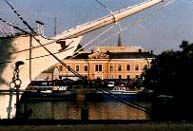 This country of five million, which is generally perceived as liberal and egalitarian, was the first in Europe to give women the right to vote in 1906, and elected its first female president, Tarja Halonen, this year. Halonen, who has supported gay and lesbian rights for years, was the chairwoman of SETA for a brief term in the 1970s.
This country of five million, which is generally perceived as liberal and egalitarian, was the first in Europe to give women the right to vote in 1906, and elected its first female president, Tarja Halonen, this year. Halonen, who has supported gay and lesbian rights for years, was the chairwoman of SETA for a brief term in the 1970s.
When the law is passed, Finland will follow in the footsteps of Norway, Sweden, Denmark and Iceland, all of which have legalized homosexual relationships. Holland has similar legislation, and Germany is following suit.
Recent Changes
Over the past five years, Hilkka has seen a distinct change in the attitudes toward homosexuality in her country. Why, I asked. Without the slightest tip to the European Codes or SETA’s lobbying efforts or the liberal legislators who will actually vote on the law, Hilkka shot out, “Madonna!” We all laughed, but she was serious, pointing out the singer’s bisexual public demeanor backed up by her self-confidence she displays in her high-drama concerts and her real life. “People are very influenced by people like her; artists always bring about change. They are not afraid to push into the future.”
The other reason for change, said Hilkka, is a function of age and generation. “Today many straight young people like our gay places; in fact, many prefer them to the chauvinistic straight bars and clubs. The rave dances here are very mixed–and we know how to party better!” Her friends agreed through their laughing.
More on Relationships
Further conversation with these modern gay folks followed some days later. Since the culture is non-threatening and receptive to gay individuals and couples, relationships are not focused around survival and secrecy. Rather, as in other developed nations, romance is more concerned with affairs of the heart and mind. Psychology and personality, problem solving, trust and commitment dominate relationships in the early years as the two individuals work at blending their differences and similarities.
On being a couple, Tuomas expressed some thoughts: “it’s not easy being a couple, though. I’ve been discussing this issue with some of my (gay) friends. Being a couple changes a lot of things. The gay scene (bars and discos) seems to have negative approach to steady-going couples. We’ve found so few new gay friends since we started dating. Before people would just come and talk with me in the bars. Not any more. Maybe because they think I am not available, so they don’t want to talk?”
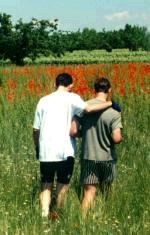 On the other hand, Petri noticed that some other guys don’t seem to respect couples. “They will come up and cruise me even when I am standing next to Tuomas and talking with him. I wonder how they ignore him or why. But he talks to them anyway after a while–I think maybe a little jealous,” he laughed and stroked Tuomas hair as reassurance.
On the other hand, Petri noticed that some other guys don’t seem to respect couples. “They will come up and cruise me even when I am standing next to Tuomas and talking with him. I wonder how they ignore him or why. But he talks to them anyway after a while–I think maybe a little jealous,” he laughed and stroked Tuomas hair as reassurance.
I commented that communication and solving problems were very important and sometimes difficult since partners don’t want to hurt each other. Petri offered: “Tuomas and I are very different from each other so we have to talk often to keep our feelings known to each other. That seems to be our secret as well. Talking and discussing our feelings. Being this young means that our lives and destinies (I hope I’m not sounding fatalistic) keep on evolving all the time, so if we don’t keep talking to each other openly and frequently I don’t think we would be in this relationship any more.” It was wisdom coming from the mouth of babes, but it came from experienced babes.
Hilkka’s was somewhat less enthusiastic about the success of relationships: “It is amazing to see a few long-standing couples so happy together! It’s very rare, though. Seems somehow you can never be sure that things will last. And it can be very discouraging. At the moment, of all my friends, Tuomas and Petri have been together the longest time with their three years, and even they are so young that anything is likely to happen.”
I responded to her gloomy yet realistic thoughts: “the older I get and the more couples I see staying together or falling apart, I think there is a lot of ‘luck’ in relationships. Luck meaning ‘chance compatibility’, where two people accidentally or naturally get along and feel in sync with each other. This is quite a separate issue than sexual appeal, which is a lot more common and intense than compatibility.
 “I think many couples are drawn in by sex appeal and are held there by erotic energy for a while and only later discover they don’t have a natural harmony for each other… It’s very confusing when we’re in the middle of it all, so much tension and drama. It’s easy to say the best action is to be up front, honest, become friends and live apart, but feelings are so raw and unclear when they are aroused. It’s no one’s fault really. Sex is easy but compatibility is more complicated.”
“I think many couples are drawn in by sex appeal and are held there by erotic energy for a while and only later discover they don’t have a natural harmony for each other… It’s very confusing when we’re in the middle of it all, so much tension and drama. It’s easy to say the best action is to be up front, honest, become friends and live apart, but feelings are so raw and unclear when they are aroused. It’s no one’s fault really. Sex is easy but compatibility is more complicated.”
These conversations were lively and intimate, fresh with the spirit of hope and sexual energy . The issues and concerns here in this land of 188,000 lakes were not dissimilar to those of my own friends at home. It is when basic survival is not at stake that relationships open to the natural complexity of love and intimacy.
HIV
HIV cases in Finland have been very few. Only about 500 cases have been reported so far, the majority of which are heterosexual IV drug users. It’s very rare to hear of a case of a gay person with HIV. The education about sex is very open and medical advice is everywhere available. Access to excellent health care is immediate and one can expect the best of treatment. The disease does not carry the same stigma as in other countries.
Helsinki Gay Life
There are only a few lesbigay venues in Helsinki. This apparent paucity is mostly due to the low-key necessity. Gay and straight folks frequently mix at the same hot spots. There is only one gay bathhouse in all of Helsinki and it is recent and small. The age of consent for gay sex is sixteen.
The website for Gay Helsinki (see Link) lists about fifteen places including sex shops, bars, clubs and cafe/restaurants, but even some of these are mixed. There are public swimming pools, one of which has nude swimming (for men and women on different nights). Baffin Bookstore is a cheerful place for finding much gay literature and information, in English, about happenings in Helsinki and elsewhere around the country including the annual Gay Film Festival in the southwest coastal city of Turku.
Tom of Finland
No story on gay Finland is complete without acknowledging the worldwide reputation and influence of the artist Tom of Finland, whose real name was Touko. Born on 8 May 1920, he discovered his artistic talent as well as his sexuality in the rural countryside and in the military. Many of his drawings were done in private and expressed his fantasy life which often centered on those two impressionable themes.
 From the website of the Tom of Finland Foundation (see Link), his brief biography describes that “he did freelance artwork – advertising, window displays, fashion design. In the evenings, he played the piano at parties and cafes, becoming a popular member of Helsinki’s post-war bohemian set. He avoided the fledgling gay scene, because what were then called “artistic” bars were dominated by the flamboyant effeminacy typical of the time. He traveled frequently, becoming very familiar with the gay cruising areas found in every major city. Still, in 1953, when he met Veli, the man with whom he would live for the next 28 years, it was on a street corner a few blocks from home.
From the website of the Tom of Finland Foundation (see Link), his brief biography describes that “he did freelance artwork – advertising, window displays, fashion design. In the evenings, he played the piano at parties and cafes, becoming a popular member of Helsinki’s post-war bohemian set. He avoided the fledgling gay scene, because what were then called “artistic” bars were dominated by the flamboyant effeminacy typical of the time. He traveled frequently, becoming very familiar with the gay cruising areas found in every major city. Still, in 1953, when he met Veli, the man with whom he would live for the next 28 years, it was on a street corner a few blocks from home.
“At the end of 1956, at the urging of a friend, Touko sent his secret artwork to a popular American muscle magazine…and signed them “Tom”. The editor loved them. The cover of the spring 1957 issue of “Physique Pictorial” features a laughing lumberjack, drawn by “Tom of Finland”. It was a sensation. Touko became Tom of Finland. The rest is history.”
There is probably no other gay artist whose work is so broadly recognized across the globe.
PS: A Nod to Jean Sibelius
Jean Sibelius (1865-1957) was not gay, but this most famous of Finland’s composers wrote classical music (including the very popular ‘Finlandia’, a sort of national anthem) which has for over a century had wide universal appeal. As a gay man, I have long admired the beauty and strength of his symphonies and tone poems.
 A short drive north of Helsinki is his lovely wooden home set in a sylvan glen where he lived for many years with his family and composed many of his great works. His private gazebo, where he created his beautifully complex music, is still standing.
A short drive north of Helsinki is his lovely wooden home set in a sylvan glen where he lived for many years with his family and composed many of his great works. His private gazebo, where he created his beautifully complex music, is still standing.
His life is not really part of this story, but it was a special honor to visit his home and his grave. He continues to provide profound artistic experiences to audiences around the world through his work. In Helsinki’s Jean Sibelius Memorial Park, there is a beautiful sculpture (photo left) of the composer set among the rocks and trees which he felt were part of his soul.
Also see:
Gay Finland News & Reports 2000 to present
Gay Finland Photo Gallery
















